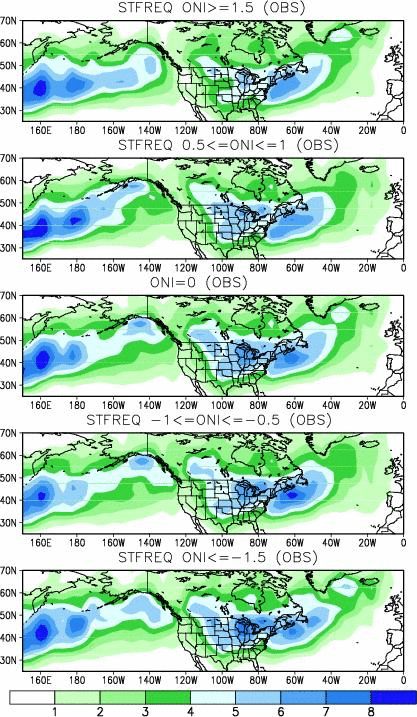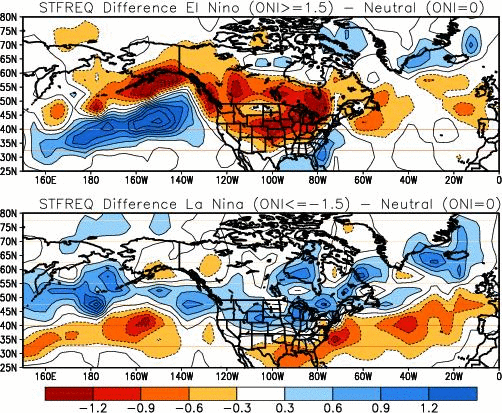|
|
HOME > Climate & Weather Linkage > Northern Hemisphere Storm Track Monitoring
|
| |

|
| |
|
|
Storm tracks are based on an algorithm developed at the Climate Diagnostics Center (CDC) [Serreze (1995), and Serreze et al. (1997)]. Storm tracks are identified by locating grid points in which the sea level pressure (SLP) is less than its surrounding grid points by at least 1 hPa. The storms are tracked by analyzing the position of systems between time steps and applying a maximum distance threshold between candidate pairings (800 km) and additional other quality control checks. Red/blue dots indicate active storms as of 18 UTC for the respective plot ending date.
|
- Short-term Monitoring, Outlooks, and Assessment
|
|
Note: Move cursor over product name to display the graphic.
|
|
|
|
|
| | |
|
[Back to the Top]
|
| |
|
|
|
Storm Track Climatology
|
| |
|
Average seasonal frequency of storms binned into 5x5 degree grid boxes for
(a) winter (JFM), (b) spring (AMJ), (c) summer (JAS), and (d) fall (OND). The frequencies are calculated from the 1950-2002 time period.
|
| |

|
|
| |
|
ENSO Composites
|
| |
|
January, February, and March (JFM) storm track frequency binned into 5x5 degree grid boxes composited by ENSO phase. Composites are calculated using the Oceanic Nino Index (ONI) defined as the three month running mean of SST anomalies for the NINO 3.4 region.
|
| |

|
| |
|
Average JFM storm track frequency difference for (top panel) strong El Nino (ONI greater than or equal to 1.5) minus Neutral conditions and (bottom panel) strong La Nina (ONI less than or equal to -1.5) minus Neutral conditions.
|
| |

|
|
| |
|
[Back to the Top]
|
|
|
|
Eichler, T. and R. W. Higgins, 2006: Climatology and ENSO-Related Variability of North American Extratropical Cyclone Activity, J. Climate, Accepted.
|
| |
|
Serreze, M. C., 1995: Climatological Aspects of Cyclone Development and Decay in the Arctic, Atmos.-Ocean, 33, 1-23.
|
| |
|
Serreze, M. C., F. Carse, R.G. Barry and J.C. Rogers, 1997: Icelandic Low Cyclone Activity: Climatological Features, Linkages with the NAO and Relationships with Recent Changes in the Northern Hemisphere Circulation, J. Climate, 10, 453-464.
|
|
| |
|
[Back to the Top]
|
|


